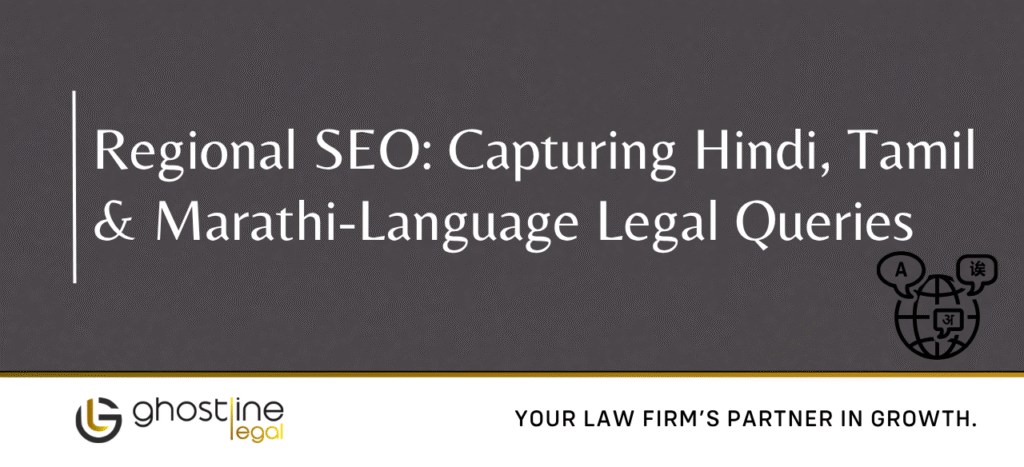This article has been authored by team Ghostline Legal.
Imagine this. A small business owner in Bhopal searches “नया कंपनी रजिस्टर कैसे करें” on Google. A working woman in Chennai types “தொழிலாளர் உரிமைகள் சட்டம்” while browsing on her lunch break. A retired teacher in Pune looks up “वारस हक्क कायदे”. These are real queries, typed in everyday language, reflecting local concerns. Yet most law firm websites miss out on this enormous slice of search traffic. Why? Because they’re not optimised for regional languages.
If you’re running a law firm in India and only investing in English-language SEO, you’re leaving valuable leads on the table. Let’s explore why and how you can capture Hindi, Tamil, and Marathi-language legal queries through regional SEO.
Why Regional SEO Matters for Law Firms
Legal services are deeply local. While English dominates corporate and high-value legal markets, a large segment of India’s population still seeks legal help in their native language.
Here’s why regional SEO is a smart move for law firms:
Real search behaviour: People Google legal questions in the language they speak daily.
Trust factor: A website that speaks their language feels more approachable.
Search engine visibility: Google is getting better at recognising multilingual intent. Local language content is showing up more prominently in results.
And with voice search growing, regional queries are only going to increase.
What Counts as Regional SEO?
Regional SEO isn’t just about translation. It’s about optimising your online presence to show up when someone searches legal questions in Hindi, Tamil, Marathi, or any local language.
This includes:
Publishing content in regional languages (not just translated, but locally adapted)
Targeting keywords in Devanagari, Tamil, or other native scripts
Claiming and optimising Google Business Profile in regional language
Using structured data with multilingual support
Building backlinks from region-specific websites and directories
Getting Started with Hindi, Tamil, and Marathi SEO
You don’t have to overhaul your entire website on day one. Here’s how to start small and grow meaningfully:
1. Identify regional search trends
Use tools like Google Trends, Ahrefs, or even YouTube’s autocomplete to find out:
What legal queries people search in regional languages
How they phrase their questions
Which topics are searched more in local scripts vs English
For example:
Hindi: “वसीयत कैसे बनाएं” (How to make a will)
Tamil: “கல்வி காப்பீடு சட்டம்” (Education rights law)
Marathi: “घटस्फोटासाठी काय प्रक्रिया आहे?” (What is the process for divorce?)
2. Create topic clusters in each language
Start with a few blog posts around common concerns. You don’t have to translate your entire blog. Instead, create original content based on how people speak and search.
Examples of blog ideas:
Hindi: “जमानत की प्रक्रिया और आपके अधिकार”
Tamil: “சட்ட ஆலோசகர் எப்போது தேவைப்படுகிறது?”
Marathi: “कोणती कागदपत्रे वारस हक्कासाठी आवश्यक आहेत?”
Use short paragraphs, local examples, and break down complex terms simply.
3. Don’t rely only on Google Translate
Machine translation won’t understand legal nuance or how people naturally speak. Work with native speakers or regional legal writers who understand the tone and usage.
Even better if they have legal knowledge. For example, the word “appeal” may be understood as “अपील” in Hindi, but the way it’s explained for a layperson matters more than just the right term.
4. Build separate regional landing pages
If you’re operating in multiple states, consider dedicated service pages for each language:
/hindi/legal-advice/tamil/property-law/marathi/family-lawyer
Make sure your meta titles, headers, and alt text are also in the target language.
5. Localise your Google Business Profile
Add regional-language descriptions and services to your Google listing. Include:
Business name in local script
Office hours
Legal services in the local language
Client reviews in Hindi, Tamil, or Marathi
This helps boost your appearance in Google’s local 3-pack when someone searches near you.
Common Mistakes to Avoid
Literal translations that feel robotic or confusing
Ignoring script-based search terms (Devanagari, Tamil script)
Creating duplicate content without localisation
Skipping regional schema markup or structured data
Not mobile-testing local language pages
Your regional SEO efforts should be human, helpful, and context-aware.
Do I Need Separate Websites?
Not necessarily. A multilingual website with properly marked language tags (hreflang) is enough. But if your firm operates in deeply distinct markets with unique services, separate microsites or subdomains could be useful.
What matters more than structure is whether the content feels natural to the user reading it.
A Word on Voice Search
In regional SEO, voice search is your friend. People are increasingly speaking their legal questions into phones rather than typing them.
Optimise for:
Question-based phrases (“क्या मैं जमानत ले सकता हूँ?”)
Natural sentence structure
Snippets and FAQs that answer one query clearly
Final Thoughts
Regional SEO isn’t a short-term hack. It’s a thoughtful strategy to meet people where they are—linguistically, culturally, and digitally.
Law firms that embrace regional SEO aren’t just improving their rankings. They’re building trust in communities that are often overlooked in digital outreach.
If you’re a legal professional or firm looking to expand your reach in India, it’s time to think beyond English.
At Ghostline Legal, we help law firms create multilingual digital strategies that actually convert.
Reach out to explore content, SEO, and local branding support rooted in regional insight.
Need SEO to boost your law firm’s online visibility? Reach out now!








